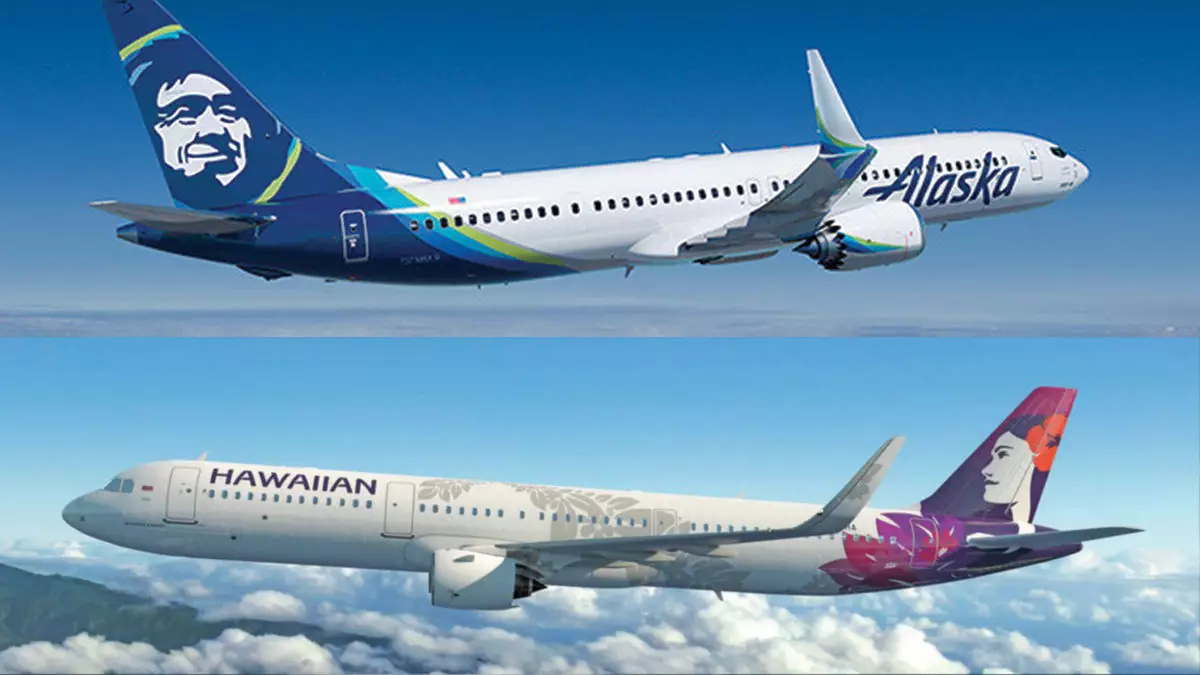In a significant development within the airline industry, Alaska Airlines is poised to finalize its acquisition of Hawaiian Airlines for an estimated $1.9 billion. This transaction comes on the heels of conditional approval granted by the U.S. Department of Transportation (DOT), marking a crucial step toward creating a consolidated airline that enhances operational capacities while expanding market presence. The consolidation was previously bolstered by the Justice Department’s decision not to contest the deal, eliminating many legal roadblocks.
While the merger may catalyze operational efficiency and expand service offerings, it also raises important scrutiny from regulatory bodies. The DOT, while supportive of the merger, has stipulated certain conditions to ensure consumer protection and market competitiveness, signaling a nuanced approach to mergers in the aviation sector.
Regulatory supervision often remains a cornerstone of any major merger, particularly in industries such as aviation that heavily influence public interests. Notably, the DOT’s approval is encumbered with stipulations designed to protect both consumers and smaller carriers. The requirement to maintain, or potentially increase, service levels on shared routes ensures that competition—and by extension, consumer choice—is preserved.
This stipulation is significant, especially for routes serviced uniquely by either airline or by only a handful of others. With the focus squarely on interisland travel within Hawaii and the preservation of existing interline agreements, the DOT is making it clear that consumers must remain at the forefront of operational strategies. Furthermore, the demand that Alaska Airlines refrain from monopolistic practices regarding access to new facilities in Honolulu signals a dedication to maintaining fair competition and encourages growth among regional airlines.
In an era where customer experience can significantly impact brand loyalty, the DOT’s expectations for improving Hawaiian’s customer service policies are exceptionally pertinent. By mandating that Hawaiian Airlines adopt measures such as guaranteed seating for children traveling with adults and issuing travel credits for significant delays, the DOT is directly influencing traveler satisfaction. Such policies indicate that regulatory bodies are not merely concerned with operational efficiencies but are also aware of the broader implications of consumer interactions within the airline industry.
Additionally, provisions to assist military personnel through waivers on fees and guaranteed luggage allowances reflect a broader understanding of the airline’s role in serving those who serve. Such regulations ensure that the airlines are accountable, aligning their business practices with the needs of specific customer demographics.
One of the more intriguing aspects of the merger lies in how Alaska Airlines plans to navigate the complex landscape of loyalty programs. The commitment to maintaining the value of HawaiianMiles during the transition to Alaska’s Mileage Plan epitomizes a thoughtful approach to customer retention. By introducing a straightforward 1-to-1 conversion ratio in loyalty points, Alaska is actively working to minimize disruptions that could alienate loyal customers.
Additionally, guaranteeing that accumulated miles will not expire within a specified period underscores Alaska’s commitment to brand loyalty and consumer trust. Such assurances reinforce the message that Alaska Airlines values its customers and aims to build a unified, robust loyalty program that honors existing memberships while inviting Hawaiian passengers into the fold.
The leadership transition that will take place with this merger is another critical factor in its probable success. Alaska Airlines has outlined a clear plan for executive continuity, ensuring that the integration process will be overseen by familiar and established figures. Alaska Airlines CEO Ben Minicucci will maintain his leadership role, while Joe Sprague, currently the regional president for Alaska’s operations in Hawaii, will step into the chief executive position at Hawaiian Airlines.
This decision to promote from within highlights a commitment to operational consistency and demonstrates that the strategic direction of the merged entity will be carefully steered by leaders who hold deep knowledge of the existing markets and customer bases.
Conclusion: A Strategic Path Forward
As the merger between Alaska Airlines and Hawaiian Airlines approaches finalization, the landscape of the aviation industry prepares for significant evolution. Both regulatory oversight and new customer-centric policies are set to shape the development of the combined airline. From safeguarding consumer interests to enhancing loyalty program frameworks, the acquisition reflects not only a strategic business move but a broader commitment to elevating the overall flying experience attuned to consumer needs. As these two airlines collaborate, the potential for revitalized air travel across new routes remains promising for consumers and industry stakeholders alike.

